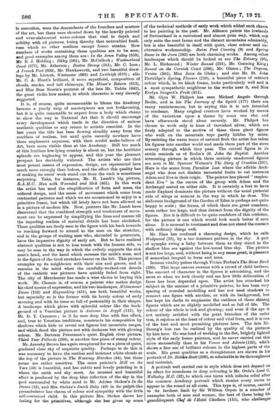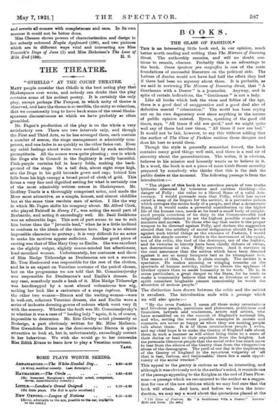ART.
THE ACADEMY.
Eppur a more.
TELE ACADSMY doors have given way, shaken by the thundering of the younger generation. No longer is a masterpiece debarred from exhibition because it is in a black frame. White or grey mounts no longer cause rejections for water-colours which do not look well when framed in gold ; indeed, in one instance this year so far has the spirit of innovation gone that an oil is hung in a white frame. It used to be said that, unless all frames were alike, and of course of gold, the work of those who hung the exhibition was made impossible ; now, when this last refuge of a reactionary is abandoned, it is seen that diversity makes for relief. But the modern spirit is not only seen in frames, and the changes are more sweeping than grey mounts, for artistic work, which a few years ago would have been certain of rejection, is now hung in prominent places. The water- colour room alone is proof of this. For the last year or two the oareful searcher has been able to find a few works which, in execution, were the descendants of the founders and masters of the art, but these were shouted down by the heavily painted and over-elaborated water-colours that vied in depth and solidity with oil pictures, losing thereby that untroubled fresh- ness which no other medium except fresco attains. Now numbers of works containing these qualities are to be seen, and good examples among them are : In the Arun Valley (559), Mr. E. J. Holding ; Ilkley (561), Mr. McCullock ; Westmorland Coast (677), Mr. Atherton ; Boston Stump (581), Mr. C. Ince ; A French Port (603), Mr. Hawksworth, and two beautiful draw- ings by Mr. Lintott, Waetwater (662) and Luatleigh (676) ; alio Mr. C. A. Hunt's brilliant, if more superficial, composition of clouds, smoke, and tall chimneys, The Miner's Return (613), and Miss Bess Norris's portrait of the late Mr. Tubbs (682), the great violin-bow maker, in which character is very cleverly suggested.
It is, of course, quite unreasonable to blame the Academy because a yearly crop of masterpieces are not forthcoming, but it is quite reasonable to expect from a body which claims to show the way in National Art that it should encourage every development which tends in the direction of serious aesthetic qualities or any return to artistic essential. In the last years the tide has been flowing steadily away from the mudflats of realism, but until quite recently nowhere have these unpleasant expanses, with their sordid make-believe of Art, been more visible than at the Academy. Still too much of this fruitless low-lying country is about us, but the healthier uplands are beginning to appear, and this year the pleasant prospect has decidedly widened. The artists who use that most potent means of expression, design, are represented here much more strongly than before, and the effect this quality has of making its users' work stand out from the ruck is sometimes surprising. Take, for instance, Mr. H. Lamb's big picture, R.A.M.C. Men with Wounded and Sick (461). In this work the artist has used the simplification of form and mass, the ordered design, and the sense of movement which come from contrasted patterns and which we are accustomed to enjoy in a primitive fresco, but which till lately have not been allowed us in a picture of modern life. Now, painters like Mr. Lamb have discovered that the combined strength and tenderness of move- ment can be expressed by simplifying the lines and masses till the impeding realism of material details has been abolished. These qualities are finely seen in the figure with his back towards us reaching forward to attend to the man on the stretcher, and in the groups of waiting men who, shrouded in greatcoats, have the impassive dignity of early art. But to have realized abstract qualities is not to lose touch with the human side, as may be seen in the way in which the orderly supports the sick man's head, and the hand which caresses the mule's nose, and in the figure of the tired stretcher-bearer on the left. This picture crumples up its neighbours with their airs and graces, and it remains in the mind when the carefully-worked-out details of the realistic war pictures have quickly faded from sight. The city of Manchester has made a wise choice in buying this work. Mr. Clausen is, of course, a painter who makes design his chief means of expression, and his two landscapes, Midsummer Dawn (153) and Haymaking (451), are both beautiful works, but especially so is the former with its lovely colour of early morning and with its trees so full of personality in their shapes. A landscape which glows with splendid colour like the back- ground of a Venetian picture is Autumn in Argyll (112), by Mr. D. Y. Cameron ; in it he uses deep blue with fine effect, and, true to Venetian traditions, constructs his composition by shadows which hide or reveal not figures but mountain ranges, and which flood the picture not with darkness but with glowing colour. Mr. Bertram Priestman's quiet English river picture, Third Year Pollards (269), is another fine piece of sunny colour.
Mr. Arnesby Brown has again recaptured for us a piece of quiet, gradated clear sky of exquisite quality. Perhaps to do this it was necessary to have the restless and insistent white clouds at the top of the picture in The Waveney Marshes (44), but these forms are rather assertive. The same painter's Mill on the Fare (38) is beautiful, and has subtle and lovely painting in it where the earth and sky meet. An unusual and beautiful effect is produced by the deep blue reflection of the sky in the pool surrounded by white sand in Mr. Adrian Stokes's In the Dunes (12), and Mrs. Stokes's Dutch Baby (49) in its pulpit-like perambulator has charm of colour and sympathy with the little self-contained child. In this picture Mrs. Stokes shows her feeling for the primitives, although she has given up some
of the technical methods of early work which added such charm to her painting in the past. Mr. .Allinson paints the lowlands of Switzerland in a restrained and almost prim way, which no only suits the neat farms and the distant mountains admirably, but is also beautiful in itself with quiet, clear colour and un-
obtrusive workmanship. Swiss Peat Country (9) and Spring Snow in the Jura (192) are both charming works. Among other landscapes which should be looked at are The Estuary (96), Mr. L. Richmond ; Winter Sunset (291), Mr. Gunning King ; Sunset on the Cornish Coast (296), Mr. Olsson ; The Dogana, Venice (341), Miss Jane de Glehn ; and also Mr. St. John Partridge's Spring. Flowers (210), a beautiful piece of reticent 'colour which, in its black frame, looks particularly well and is a most sympathetic neighbour to the works near it, and Miss Evelyn Sargent's Fruit (411).
Mr. Glyn W. Philpot has seen Michael Angelo through Rodin, and in his The Journey of the Spirit (177) there are many reminiscences, but in saying this it is not intended to condemn. Many original creators have worked by means of the variations upon a theme by some one else and have afterwards stood alone securely. Mr. Philpot has chosen to work only in hues of tarnished silver, which are finely adapted to the motive of these three giant figures who walk on the mountain tops partly hidden by mists. By resisting the warm tones of natural flesh the artist has taken his figures into another world and made them part of the stern scenery through which they pass. The central figure in its stride reminds us of Rodin's St. John the Baptist. Another interesting picture in which three entirely unadorned figures are seen is Mr. Spencer Watson's The Story of Creation (207). Here is the scene from Paradise Lost where the affable Arch- angel who does not disdain terrestrial fruits to eat instructs Adam and Eve in their origin. The painter has placed " resplen- dent Eve " in the centre of the group with Adam and the Archangel seated on either side. It is certainly a feat to have made Raphael dominate the picture without the usual pictorial aids of wings or armour in the way in which he does. The elaborate background of the Garden of Eden is perhaps not quite happy in scale ; the forms, of which there are great numbers, seem rather too large, and thus detract from the dignity of the figures. But it is difficult to be quite confident of this criticism, for the picture is one which would look much better if seen alone. It is unusual in treatment and does not stand the bontact with ordinary things well.
Mr. Sims has confused a charming design, which he calls Wedgwood (26), by a too insistent pattern in the sky. A pair of nymphs swing a baby between them as they stand in the shallow blue sea against the low-toned blue sky. The picture is not too large, and, without being in any sense great, is pleasant if somewhat languid in form and tone.
Intense vitality pulses through Vivian Forbes's The River Bank (330). This large canvas swarms with a crowd of child bathers. The amount of character in the figures is astonishing, and the more so when we look closely and see how little delineation of faces has been depended upon. The artist has attacked his subject in the manner of a primitive painter, he has been very sparing of rounded modelling and has not used shadows to connect one figure with another, or with its background, but has kept his darks to emphasize the outlines of these shining figures which are so slightly modelled and so full of life. The colour of the whole is rich and glowing; and even if the eye is not entirely satisfied with the great branches of the cedar tree, it rejoices at the feast of colour and vital form, and it is one of the best and most promising pictures here. The late Mr. Strang's loss can be realized by the quality of the pictures by him here. He was fond of working in the flat, brightly lighted style of the early fresco painters, and he never carried out this more successfully than in his Venus and Adonis (132), which shows a fine use of brilliant colours in the highest parts of the scale. His great qualities as a draughtsman are shown in his portrait of Dr. Ritchie Scott (699), so admirable in its thoroughness and restraint.
A portrait well carried out in style which does not depend on its effect for roundness or deep colouring is Mr. Orde's Lord G. Wellesley M.O. (32), to which one turns with infinite relief after the common Academy portrait which strains every nerve to appear in the round at all costs. This type is, of course, carried to its farthest limit by Sir William Orpen in a number of examples both of men and women, the best of these being his grandiloquent Chef de I 'Hotel Chatham (115), who challenges
and arrests all oomers with completeness and ease. In its own manner it could not be better done.
Miss Clausen shows powers of characterization and design in her soberly coloured Magda Ayafonord (190), and two pictures which are in different ways vital and interesting are Miss Peacock's Days of Jane (1) and Miss Zinkeisen's The Lass of




































 Previous page
Previous page